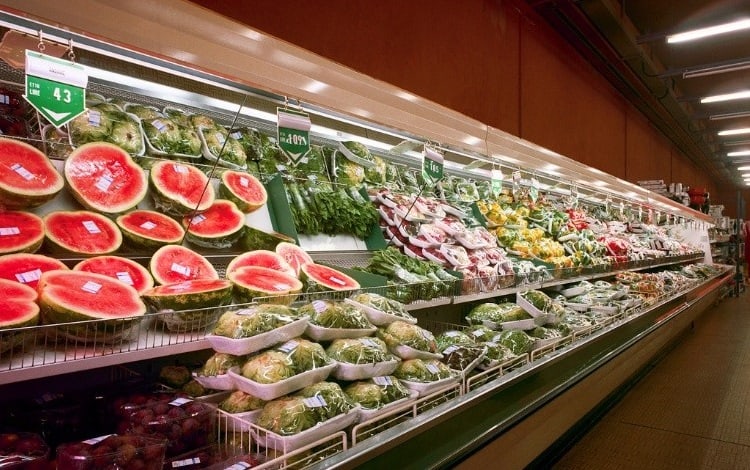You don’t need a government statistician to tell you the inflation level when you can see the price of eggs go up every time you shop. Food prices are one of the most common ways people gauge the cost of living. Cutting your grocery bill is one of the best ways to save when money is tight, but it can seem like one of the hardest. After all, everyone has to eat, right?
Fortunately, Living on the Cheap was founded by two women who literally wrote a book about saving money on groceries and other items (The Ultimate Guide to Coupons, which you can download here.) We’ve compiled a list of their top tips for saving money on food, along with advice from our other money-saving experts, taken from the many articles we’ve published on this topic.
And don’t worry, you don’t have to clip coupons to save money!

Stock up on food basics when they’re on sale
“When something is on sale for a really good price, buy enough to get around to the next sale,” says Carrie Rocha, founder of Pocket Your Dollars and a mother of two in Minneapolis.
This is especially true for meat, the building block of most American families’ main dishes. A Living on the Cheap staffer started saving more money on groceries when she began checking grocery store ads and made meal plans based on what meat is on sale. Planning your meals first and then shopping for the ingredients means you don’t take advantage of sale prices, and who can afford to do that these days?
“I think the key is really honing in on what your high-impact items are,” says Stephanie Nelson, who runs the website Coupon Mom and is author of The Coupon Mom’s Guide to Cutting Your Grocery Bills in Half. “If you can find a less expensive source, it really adds up.”

Buy produce that’s in season
Because of global supply chains, you can find almost any fruit and vegetable in your grocery all year round. But concentrating on produce that’s in season instead of something shipped in from halfway around the world will usually mean that you’ll save money. So buy your watermelon in summer and your citrus in winter.
Produce isn’t the only seasonal sale item
Even nonperishable items have a sale season, Rocha says. In winter, canned soup, baking supplies, cold medicines, canned fruits and vegetables, baking supplies and oatmeal are at their lowest prices. Summer sales focus on condiments, barbecue sauce, hot dog and hamburger buns, sunscreen, adhesive bandages and antibiotic spray.
She adds that coupon savings are seasonal, too. “When products are in season, that is when there are coupons available for them.” So clip coupons and stock up on any nonperishable items that you’re sure to use in a reasonable amount of time. Spending an extra $5 on bottles of ketchup that are just going to sit in the pantry for two years isn’t a good use of money.
Some non-food items are cheaper at drugstores
A Living on the Cheap editor has a daughter who never buys paper products or beauty items at the grocery store. She tracks CVS sales and uses the digital coupons from her store loyalty program. If the trip to the drugstore is a big detour for you, though, the savings might be eaten up by the gas you spend to get there.

Photo: Deposit Photos
Loyalty cards and smartphone apps save money
Many retailers are moving toward digital discounts through their own loyalty cards, smartphone apps and apps like Ibotta. For example, in addition to its regular paper coupons, a large Texas grocer is offering savings available only on its app. A Living on the Cheap editor says that on her most recent trip, the digital deal was worth $10 off a $50 basket of groceries. That’s a huge discount.
Sure, markets are tracking your every purchase when you sign up for a loyalty card, but shoppers who use store coupons and loyalty cards save, on average, more than 10% on groceries a year. Frequent shoppers also receive customized mailings filled with coupons four to six times a year.
Hunt for the clearance shelves
Laura Daily, one of the Living on the Cheap publishers, advises that shoppers find the clearance shelves in their local market. “Supermarkets don’t make them easy to find, but they are a treasure trove and should be your first stop,” she says.
Stockers regularly comb shelves for slightly damaged goods (for example, a torn box) or pull merchandise that is being rebranded. These “Manager’s Specials” items are marked down as much as 50%. If the product itself is undamaged (avoid dented cans), you can get a steal. Daily once found eight bars of soap marked down to $1.48. By using a $1 off coupon, she paid 48 cents.

Photo credit: ALDI stores
Try store brands or shop at discount groceries
Many people are loyal to certain brands for certain products, but it’s worth trying a less-expensive store brand to see if the price difference is really worth it. Did you know that many store brands are manufactured by the same companies who make pricier name-brand products? For example, Costco’s store-brand diapers are made by Kimberly-Clark, the manufacturer of Huggies.
If you’re fortunate enough to have a discount grocer like ALDI near you, you could be saving money on groceries compared to shopping at other chains. Read our story on How to shop and save at ALDI for tips; it’s written by a loyal and regular ALDI shopper.
Use what you buy
The most expensive food is the food you throw away. If you find yourself routinely throwing out produce, bread and meat, then you are buying too much or you’re not planning your meals ahead of time.
You can freeze or repurpose leftovers. Rocha recently used leftover mashed potatoes to make shepherd’s pie. You can also freeze most things not used immediately, including many fresh fruits and vegetables. Here’s how to freeze fresh produce.
If you’re faced with a pile of broccoli and a bag of potatoes, Rocha recommends using the allrecipes.com “search by ingredient” section to find recipes for a meal with what you have on hand. Or enter “leftovers” in the search bar at the top of livingonthecheap.com and you’ll find all of our articles about using leftovers from big holiday meals like Easter and Christmas.
To help keep fresh produce from going bad before you use it, we have lots of information for you, including articles on 5 ways to preserve food and how to preserve food using cheap canning tips. We also tell you whether buying a vacuum sealer is worth it.
A funnel is your little helper
One reason warehouse stores are popular with budget-minded shoppers is because they sell products in bulk. Instead of one bottle of all-purpose spray cleaner for $3, you can get that same bottle bundled with a one gallon jug and use a cheap funnel to refill the original bottle. Or, buy the large refills and do the same thing. Use this trick when buying any sort of nonperishable liquid such as hand soap or glass cleaner.
Consider joining a warehouse store
This one is tricky because you should always be careful of spending money to potentially save money. Also, buying perishables in bulk isn’t a good deal if the food goes bad before you use it. (See tip no. 8 above.)
Our articles Is Sam’s Club membership worth it? and Can Costco membership save you money? give you all the information you need to decide if you’ll recoup the money you shell out for a membership at either of those two big warehouse stores.
Use a credit card that gives cash back at groceries
Like tip no. 10 above, this is a tip where one size definitely doesn’t fit all. You shouldn’t use a credit card for any routine expenses if you aren’t going to pay the entire credit card bill off each month. Also, applying for a new credit card can cause a temporary drop in your credit rating.
However, a Living on the Cheap editor uses her American Express Blue Cash Preferred card every time she goes to the grocery store and gets 6% back. (The card also offers 3% back at gas stations.) One caveat: Groceries bought at warehouse stores or big-box retailers like Super Target aren’t eligible for the discount.
If you liked this post, you may also like:

